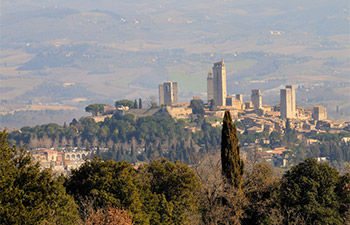
 San Gimignano
San Gimignano, near
Siena in
Tuscany, has an architectonic structure, a political system and an economy which developed between the end of the eleventh and the mid thirteenth century.
The city's maximum development occurred in those centuries and continued up until 1348, the year of the great plague, and 1353, the year in which it surrendered to Florence.
Documents relate to us the history of the town from its
Etruscan and
Roman origins to the development of the historic center, thanks to the
Francigena route - important for commercial trade, pilgrimages and exchange of knowledge - which crossed its entire length and brought wealth and well being.
As of 1056 its most important churches - from the Collegiata to the minor ones scattered around the city and the countryside - gained importance.
Around 1100 the political establishment of
San Gimignano became predominant and the consular and podestà regimes followed one another, and surrounded the town with a 2176 meter long wall, with numerous doors placed at intervals.
The activity of its merchants, who exported wine (
Vernaccia and Greek Wine) and saffron, and imported other products from everywhere in Europe, begetting enormous wealth.
This wealth thus accumulated was re-invested in palaces and towers, as well as in large and small land holdings, generous alms-giving, donations and works of art.
The fame of the town is owed to all of this, renowned worldwide as it is for its architecture, churches and treasures of art - which over the course of the centuries were robbed and dispersed several times.
That which remains has been admirably saved and is today hosted in churches, museums and art structures, which everybody can visit and admire to their great pleasure.
Thanks to this,
San Gimignano is
one of the most renowned cities in the world and has been declared
cultural heritage of the world by Unesco.